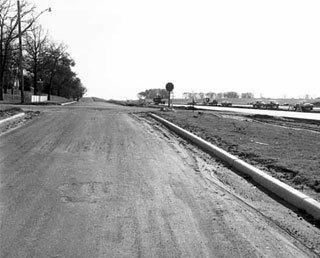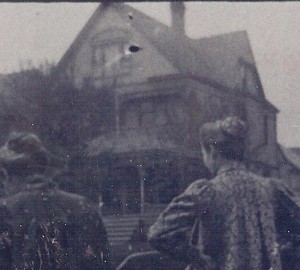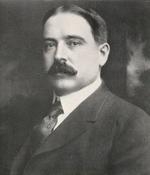Note: This is a corrected version of the May 23rd posting, edited after a recent interview with Wayne Tinberg. A new post on that interview will follow.
 |
| The roadbed for 35W being laid in Richfield in 1960. |
The previous blog post was devoted to three Healy houses lost to freeway construction and one to changes in fashion. So far, the entries on this blog have presented the building list of Healy houses in roughly chronological order.
At this point, it may be helpful to take a look specifically at all the houses wrecked for I-35W construction in 1959-60, no matter what their building date.
According to city records, nine houses designed by T.P. Healy were built on the west side of the 3100 block of Second Ave. South. In order of house number, they are:
3106, built in 1888 for $3,000
3108, built in 1888 for $3,000
3116 (directly across the street from the Healy family home), built in 1896 for $4,500
3120, built in 1892 for $9,000
3130, built in 1889 for $5,000
3132, built in 1889 for $5,000
3136, built in 1891 for $7,000
3140, built in 1887 for $6,000
3142, built in 1887 for $4,000
Here they are again, in order of year built:
1887–3140
3142
1888–3106
3108
1889–3130
3132
1891–3136
1892–3120
1896–3116
 |
| An old photo of 3130 Second Avenue (courtesy Robert-Jan Quene). It would be interesting to find more photos of these lost Healy houses. |
One can deduce that the three pairs of houses built side-by-side in the 1880s were probably built on spec by Healy. The house built in 1891 is apparently a much fancier house, a stone veneer dwelling costing $7,000. The one from the next year, 1892, a brownstone, is fancier yet, erected for the princely sum of $9,000.
The most famous resident of that block was Richard W. Sears, co-founder of the Sears and Roebuck Company.
According to the Sears company archives:
Richard Warren Sears was born December 7, 1863, in Stewartville, Minn. Although Sears’ father was at one time fairly prosperous, he lost all of his money—about $50,000—in a failed stock-farm venture.
Consequently, at a young age, Richard Sears found it necessary to work in order to help support the family. Working as a station agent for the Minneapolis and St. Louis Railroad, Sears looked to supplement his income. In 1886, he found an ideal solution when a local jeweler refused a consignment of watches. Sears asked the manufacturer’s permission to try to sell the watches. Permission was granted, and soon he had sold all of them to fellow agents.
Within six months, Richard Sears’ watch business escalated so much that he resigned from the railroad in 1886 and moved to Minneapolis, where he could devote full time to his growing mail-order enterprise, which he founded that year as the R.W. Sears Watch Company. He was only 22 years old.
Sears joined forces with watch repairman Alvah C. Roebuck in 1887 and then with key financier and future president and chairman Julius Rosenwald in 1895. The headquarters of Sears, Roebuck and Co. had been established in Chicago in 1893.
In 1908, poor health forced Richard Sears to retire from active participation in his company, which had grown to annual sales of $40 million. He died six years later.
The chronology of Sears’ rise is interesting. When Sears bought 3132 from Healy in 1889, the latter was only 26 years old. By then, Sears had partnered with Roebuck and set up the company that bore their names (today, only Sears’ name remains).
 |
| “If you buy a good watch you will always be satisfied, and at our prices a good watch will influence the sale of another good watch; and that’s our motto: “Make a Watch,Sell a Watch.” (Richard Sears in 1892) |
Wayne Tinberg, who bought the Healy-built house at 3124 Third Avenue South in 1959, told Madeline Douglass that the homeowners on that block used to celebrate Healy’s birthday each year–hence the hastily-organized birthday celebration behind Healy’s family home at 3115 this year. It is remarkable that even many years after Healy’s death, the people who lived in the houses he built on Second Avenue remembered and celebrated his work.
The “urban removal” of the 1950s and ’60s changed all that and brought many Victorian houses into the clutches of slumlords or in front of the paths of bulldozers. The revival begun in the ’70s with the designation of the Healy block to the historic register continues today, through fits and starts, enduring ups and downs. But sadly, for many houses in Central Minneapolis, the danger from bulldozers, slumlords, and “flippers” has not gone away. The housing crisis of 2008 has only made it worse.
Much research remains to be done on the architectural legacy of Healy, including work on his connection with Sears and many other prominent people of his day in Minnesota. If people value something, they will make an effort to keep it safe, and it is through this research that we hope to preserve T.P. Healy’s splendid architectural legacy.
–T.B.



